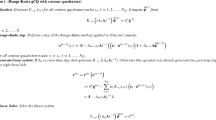Abstract
Runge–Kutta based convolution quadrature methods for abstract, well-posed, linear, and homogeneous Volterra equations, non necessarily of sectorial type, are developed. A general representation of the numerical solution in terms of the continuous one is given. The error and stability analysis is based on this representation, which, for the particular case of the backward Euler method, also shows that the numerical solution inherits some interesting qualitative properties, such as positivity, of the exact solution. Numerical illustrations are provided.
Similar content being viewed by others
References
Araujo A., Ferreira J.A. and Oliveira P. (2005). Qualitative behaviour of numerical travelling solutions for reaction-diffusion equations with memory. Appl. Anal. 84: 1231–1246
Arendt W., Batty C.J.K., Hieber M. and Neubrander F. (2001). Vector-valued Laplace transforms and Cauchy problems. Birkhäuser, Basel
Bolley C. and Crouzeix M. (1978). Conservation de la positivité lors de la discrétisation des problèmes d’évolution paraboliques. RAIRO Anal. Numér. 12: 237–245
Brenner P. and Thomée V. (1979). On rational approximations of semigroups. SIAM J. Numer. Anal. 16: 683–694
Crouzeix M., Larsson S., Piskarev S. and Thomée V. (1993). The stability of rational approximations of analytic semigroups. BIT 33: 74–84
Cuesta E. and Palencia C. (2003). A numerical method for an integro-differential equation with memory in Banach spaces: Qualitative properties. SIAM J. Numer. Anal. 41: 1232–1241
Ehrhardt, M.: Discrete artificial boundary conditions. Ph.D. Thesis, Technische Universität Berlin (2001)
Hersch R. and Kato T. (1979). High-accuracy stable difference schemes for well-posed initial-value problems. SIAM J. Numer. Anal. 16: 670–682
Horsthemke, W.: Pattern formation in random walks with inertia. In: Kish, L.B., Lindenberg, K., Gingl, Z. (eds.) Noise in Complex Systems and Stochastic Dynamics III, Proceedings of SPIE, vol. 5845, pp. 12–26 (2005)
MacKelvey R. (1965). Spectral measures, generalized resolvents and functions of positive type. J. Math. Anal. Appl. 11: 447–477
Kovács M. (2005). On positivity, shape and norm-bound preservation of time-stepping methods for semigroups. J. Math. Anal. Appl. 304: 115–136
Larsson S., Thomée V. and Wahlbin L. (1991). Finite-element methods for a strongly damped wave equation. IMA J. Numer. Anal. 11: 113–142
Lubich C. (1988). Convolution quadrature and discretized operational calculus. I. Numer. Math. 52: 129–145
Lubich C. (1988). Convolution quadrature and discretized operational calculus. II. Numer. Math. 52: 413–425
Lubich C. (2004). Convolution quadrature revisited. BIT 44: 503–514
Lubich Ch. and Ostermann A. (1993). Runge–Kutta methods for parabolic equations and convolution quadrature. Math. Comput. 60: 105–131
Palencia C. (1993). A stability result for sectorial operators in Banach spaces. SIAM J. Numer. Anal. 12: 1373–1384
Palencia C. (1995). Stability of rational multistep approximations of holomorphic semigroups. Math. Comput. 64: 591–599
Prüss J. (1993). Evolutionary Integral Equations and Applications. Birkhäuser, Basel
Spijker M.N. (1984). On the relation between stability and contractivity. BIT 24: 656–666
Sz.-Nagy B. and Foias C. (1970). Harmonic Analysis of Operators in Hilbert Spaces. North-Holland, Amsterdam
Zisowsky A. and Ehrhardt M. (2006). Discrete transparent boundary conditions for parabolic systems. Math. Comput. Model. 43: 294–309
Author information
Authors and Affiliations
Corresponding author
Rights and permissions
About this article
Cite this article
Calvo, M.P., Cuesta, E. & Palencia, C. Runge–Kutta convolution quadrature methods for well-posed equations with memory. Numer. Math. 107, 589–614 (2007). https://doi.org/10.1007/s00211-007-0107-9
Received:
Revised:
Published:
Issue Date:
DOI: https://doi.org/10.1007/s00211-007-0107-9




